Dysentery bush is a common name for several Australian plants and may refer to:
- Alyxia buxifolia
- Grewia latifolia , endemic to Northern and Eastern Australia
- Grewia retusifolia
Dysentery bush is a common name for several Australian plants and may refer to:
Sycamore is a name which has been applied to several types of trees, but with somewhat similar leaf forms. The name derives from the ancient Greek συκόμορος (sūkomoros) meaning "fig-mulberry".
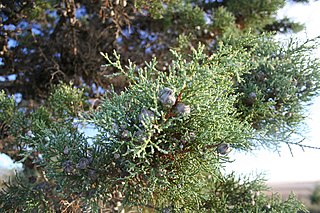
Cypress is a common name for various coniferous trees or shrubs of northern temperate regions that belong to the family Cupressaceae. The word cypress is derived from Old French cipres, which was imported from Latin cypressus, the latinisation of the Greek κυπάρισσος (kyparissos).
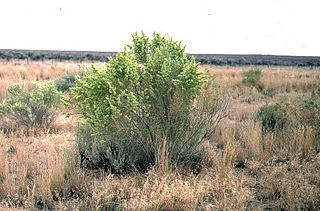
Saltbush is a vernacular plant name that most often refers to Atriplex, a genus of about 250 plants distributed worldwide from subtropical to subarctic regions. Atriplex species are native to Australia, North and South America, and Eurasia. Many Atriplex species are halophytes and are adapted to dry environments with salty soils.
Starflower or star flower may refer to:

Grewia villosa is a shrub, often scrambling and hardly exceeding 4 m in height. Leaves are fairly large, serrated and heart-shaped. It grows naturally, mainly in dry habitats. It is common in most of the semi-arid parts of Eastern Africa but may now be rare in parts of its natural distribution. Seen in Ein Gedi oasis in Israel, common in South Africa. Its ripe copper-coloured fruits are eaten in East Africa.
Vincentia may refer to:
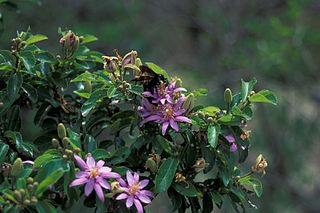
The large flowering plant genus Grewia is today placed by most authors in the mallow family Malvaceae, in the expanded sense as proposed by the Angiosperm Phylogeny Group. Formerly, Grewia was placed in either the family Tiliaceae or the Sparrmanniaceae. However, these were both not monophyletic with respect to other Malvales - as already indicated by the uncertainties surrounding placement of Grewia and similar genera - and have thus been merged into the Malvaceae. Together with the bulk of the former Sparrmanniaceae, Grewia is in the subfamily Grewioideae and therein the tribe Grewieae, of which it is the type genus.

Black wattle is the common name for a number of species of trees that are native to Australia, as listed below:
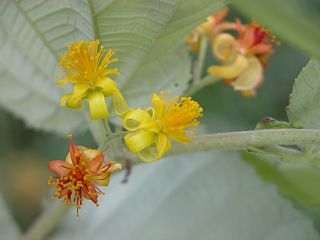
Grewia asiatica, commonly known as phalsa or falsa, is a species of flowering plant in the mallow family Malvaceae. It was first found in Varanasi, India, and was taken by Buddhist scholars to other Asian countries and the rest of the world. Grewia celtidifolia was initially considered a mere variety of phalsa, but is now recognized as a distinct species.

Palpita vitrealis, common name jasmine moth or white pearl, is a species of moth of the family Crambidae.

Grewia retusifolia is a shrub species in the family Malvaceae. Common names include dysentery bush, emu-berry, dog's balls, turkey bush and diddle diddle. It is widespread in tropical and subtropical areas of Eastern Australia and Northern Western Australia. The species produces small, sweet, two-lobed fruit with a fibrous acidic pulp surrounding the seeds. Leichhardt described the fruits as having a very agreeable taste, which could be boiled to make a refreshing drink. Indigenous Australians use the bark and leaves in medications. The crushed leaves were used as a poultice to relieve toothaches.
Emu berry is a common name for several Australian plants and may refer to:
Turkey bush is a common name for several plants and may refer to:
G. salicifolia may refer to:
G. orientalis may refer to:

Grewia occidentalis, the crossberry, is a small, hardy, attractive tree indigenous to Southern Africa.

Grewia latifolia is a small shrub that is endemic to Northern and Eastern Australia. Itsfruits have a distinct similarity to dog testicles, giving rise to the common name of dogs balls. Other common names include emu berry and dysentery plant.
Hey Diddle Diddle is a well-known English nursery rhyme.

Grewia bicolor, called bastard brandy bush, false brandy bush, two-coloured grewia, white-leaved grewia, white-leaved raisin, white raisin and donkey berry, is a species of flowering plant in the family Malvaceae, native to Sub‑Saharan Africa, Yemen, Oman, and the Indian Subcontinent. In Africa Grewia bicolor is one of the most important forages during the dry season, when all herbivores, wild and domestic, find it palatable. It is particularly enjoyed by giant eland and domestic goats.
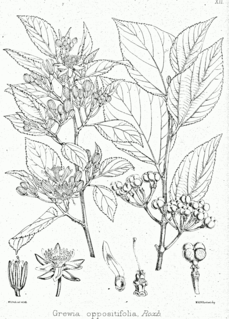
Grewia oppositifolia is a currently accepted species of flowering plant in the family Malvaceae, native to the Indian Subcontinent. It has many similarities with and may be a synonym of Grewia optiva ; certainly they share the same range, habitat, appearance, growth form, common names, and local uses as a source of forage, timber, fruit, and medicine.